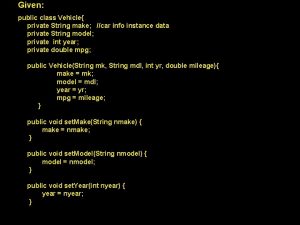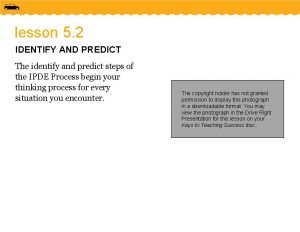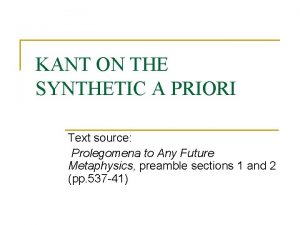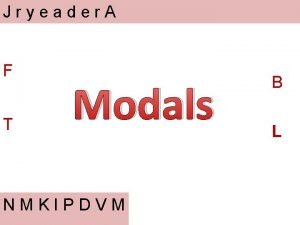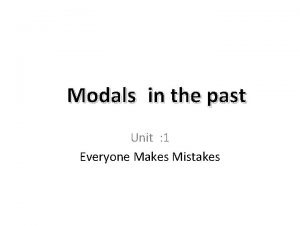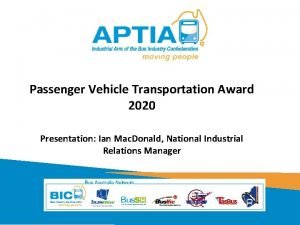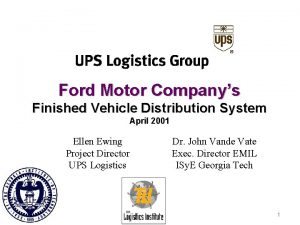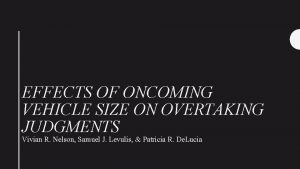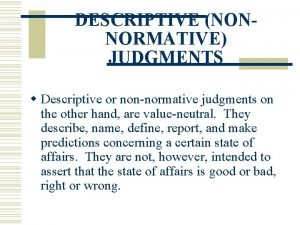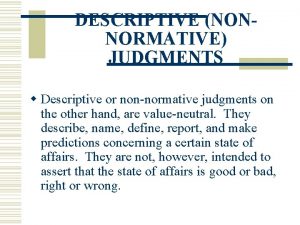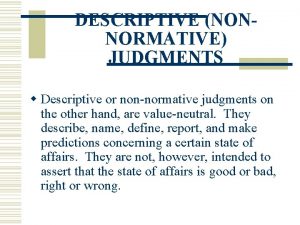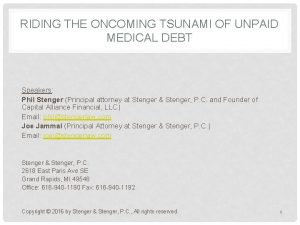Effects of Oncoming Vehicle Size on Overtaking Judgments











- Slides: 11

Effects of Oncoming Vehicle Size on Overtaking Judgments Vivian Nelson Mentor: Dr. De. Lucia

Purpose • The purpose of this study is to examine whether overtaking judgments are influenced by the size of an oncoming vehicle even when the actual threat of the oncoming vehicle is removed.

Background • Passing a lead car, or overtaking, is a risk event that results in fatal collisions. When judging if it is safe to overtake, drivers must judge when oncoming cars in the opposite lane will reach them. Levulis and De. Lucia conducted two experiments using a driving simulation of a car-following scene. Participants were asked to judge whether it was safe to overtake the lead car.

Experiment 1 Experiment 2 • Oncoming vehicles alternated between a motorcycle, a car, or a truck on a two-lane highway • There was a small motorcycle and large motorcycle, as well as a small truck and large truck • Participants accepted more gaps in front of the motorcycle than in front of the car or truck. • Participants accepted more gaps in front of the smaller motorcycle and smaller truck than the large motorcycle and large truck. • The type of vehicle was confounded with the size of the vehicle • An alternative explanation remained

Question? The question for the current experiment is this: If we eliminate the real threat of head-on collisions will overtaking judgments still be influenced by the size of an oncoming vehicle?

Method • Simulations and task are like the prior experiments except that a three-lane road was used • Participants will judge whether it is safe to overtake the lead car before the oncoming car reaches the point in the road adjacent to where they would reenter the right lane safely. • Passive condition and active condition Levulis et. al (2015)

Independent Variables Dependent Variables • Vehicle size and type (e. g. : small & large motorcycle + small and large truck) • Percentage of accepted gaps • Speed of oncoming vehicle • Speed of participant's vehicle • Gap size • Number of false alarms • Sensitivity • Response bias

Expected Results I expect the size of an oncoming vehicle to still influence overtaking judgments, even when the real threat of head-on collision is eliminated. That is, I expect the results of the first two experiments which showed an effect of size on judgments will be supported when this alternative explanation of threat is ruled out.

What am I learning? Ultimately, we will learn that overtaking collisions are partly due to misjudging the distance and speed of oncoming vehicles.

Practical Implications This research can be used to improve traffic safety. For example, it could potentially lead to the development of an “overtaking assistant” in to help drivers make better decisions. At the very least, results can be used to educate drivers to help prevent accidents.

Thank You.
 Love unfailing overtaking my heart
Love unfailing overtaking my heart What does the first apparition tell macbeth
What does the first apparition tell macbeth Cosmic superclass in java
Cosmic superclass in java Past modals should have could have
Past modals should have could have The first step in the ipde process is
The first step in the ipde process is Synthetic a priori judgments
Synthetic a priori judgments I wasn't or i didn't
I wasn't or i didn't Perfect modals examples
Perfect modals examples Const char * vs char * const
Const char * vs char * const Which mechanism helps in size separation by sieve shaker?
Which mechanism helps in size separation by sieve shaker? Passenger transport award
Passenger transport award Finished vehicle distribution visibility
Finished vehicle distribution visibility


